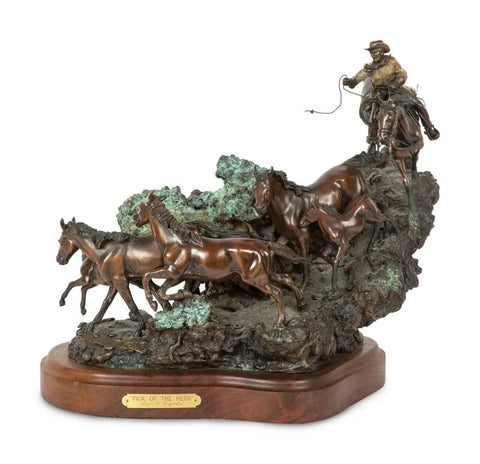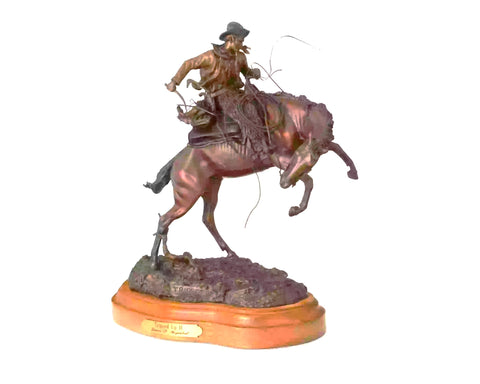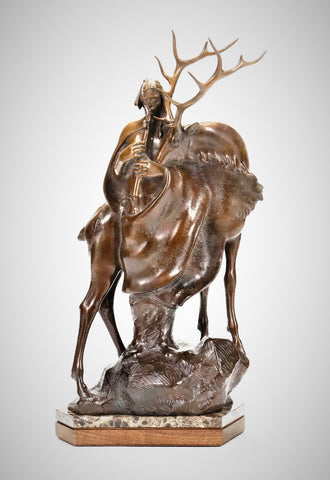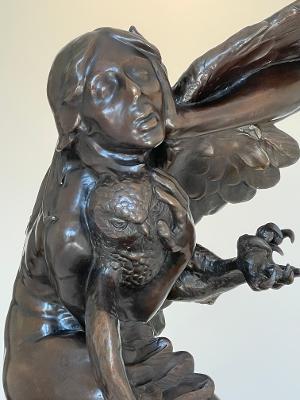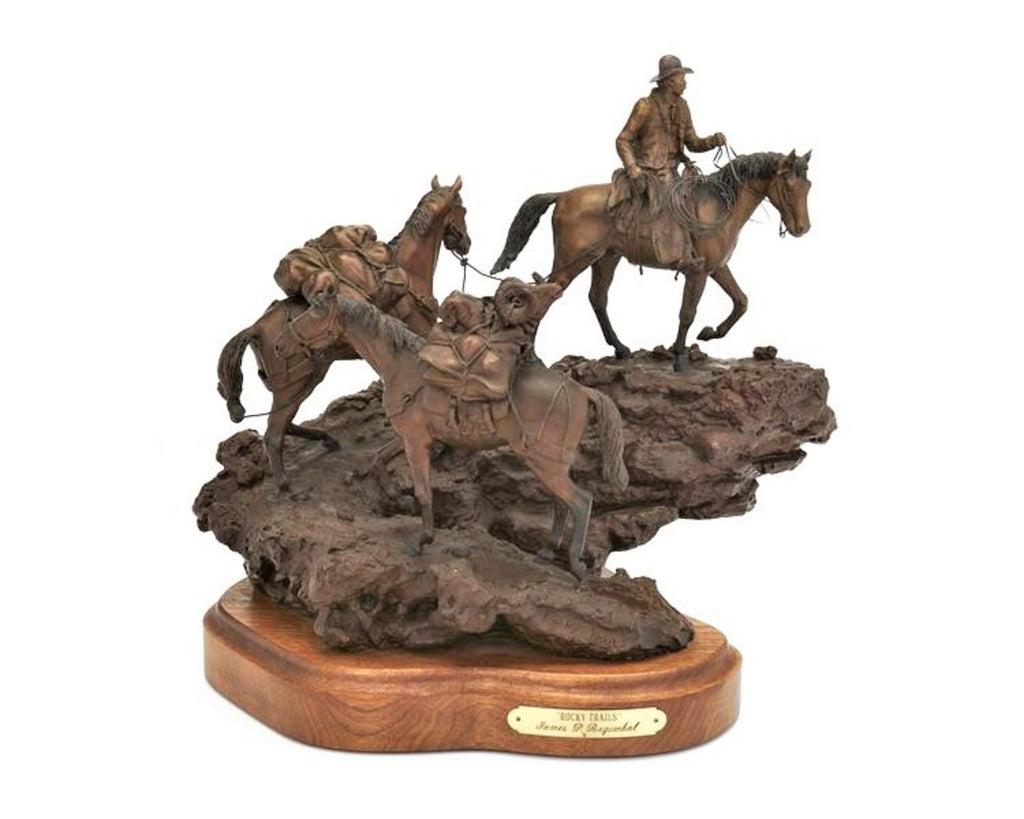
Western Bronze, "Rocky Trails" by James Regimbal, Limited Edition, 41/50, Ca 1986 #C1708
$ 10,350.00
Looks like it is Christmas in September. Had a delivery waiting for me when I arrived in the Gallery this morning. It was another outstanding Bronze Sculpture by the renown Western Artist, James P. Regimbal. Details follow.
It is titled, "Rocky Trails" by James Regimbal, Limited Edition, 41/50, Ca 1986 #C 1708
Dimensions: 14" high x 17" Wide x 9" deep
Condition: Excellent for its age
Provenance: The Passionate Eye in Santa Fe and the Estate of Dr. David Scott.
Some background on Dr. David Scott. "Dr. David W. Scott was the Director of Opera and Chairman of the Voice Department at California State University Northridge for over 35 years, where he conducted and staged more than 125 major opera productions. Many of these productions were acclaimed by local and regional critics, including a Pulitzer Prize-winning music critic for the Los Angeles Times who described him as “talented, productive, [and] unflinching pioneer” in developing opera in Los Angeles. He produced and directed more than 1000 performances of opera for young people in southern California schools, the Hollywood Bowl and other local venues. He was highly sought out for his skill and expertise as a voice teacher and had many students who won prestigious national and international voice competitions, and who enjoyed regional, national and international professional careers in opera.
After undergraduate and graduate studies at Indiana University, David Scott began his professional career as an Associate Professor of Music at Eastern New Mexico University, in Portales, New Mexico. While there in the late 1950’s he was able to attend opera productions at the newly-formed Santa Fe Opera Company in Santa Fe, New Mexico, an annual tradition he continued throughout his life, until his death in 2012. It was while visiting Santa Fe that he developed his interests in collecting art from Native American and American artists.
Artist: James Regimbal strives to pass on the true story of our American heritage through his bronze sculpture. According to James:
"Only the best of my work is good enough to be cast in bronze. Work that has been fully designed and completely executed should have this liberty. It's not the cost of bronze itself, though very expensive to have cast, but the everlasting life and beauty of bronze. Knowing that in years to come these sculptures will still be in existence and appreciated, passing on a true story of our heritage. The demand we put on creating excellence today is to show our selves and future generations. The work that has been completed in this life long collection is a culmination of decades of genuine American creativity, craftsmanship ,labor and talent. Like in the past, as in European country's the artist and craftsmen would work without seeming end. Time wasn't of the essence, but quality, accuracy and demand for excellence was always present in those days.
The quality the old masters achieved with limited tools, compared today, is astounding, but the quality in this contemporary historical western collection is of the same. Perfection from me as the artist is the first step, the pride of workmanship from over fifty artisans, men and women laboring on these bronze limited editions. The foundry men sacrificed to bring out the best in their foundry's, not to forget the agents, dealers and gallery's demanding the best works from the artist and foundry's. The important people keeping the art going are the collectors in the world, the patrons of the arts who purchase and support the work, displaying it in their homes and keeping our historical culture alive. These are some of the most important ingredients in helping an artist continue to strive for the best works he or she possibly can create Hopefully my work will stand the test of time, and the realistic nature of the work will tell and keep alive a part of our romantic American history for generations to come."
Regimbal creates very detailed, historically accurate bronzes. Taking his inspiration from true to life western books and western movies. Regimbal has detailed all aspects of the cowboy's life from the pre-1900. Subjects such as packers, Indians, warriors, hunters, story tellers, cavalrymen and bronco busters have all been accurately portrayed down to the minutest details by this talented sculptor. Regimbal researches every detail - buckles, pack items, saddles - all in an attempt to bring to life each scene in history as if the viewer were actually there.
Regimbal's demand for excellence has resulted in hundreds of national and international collectors including the University of Montana Foundation, which has the complete collection of his works and the Rocky Mountain Elk Foundation. The artist has received the George Phippen Award, and Southern Nevada Communications uses his bronzes for logos in their advertisements. It is Regimbal's desire that his sculptures will stand the test of time and keep alive a part of our romantic American history for many generations to come." (Source: May Gallery)
Creating the James Regimbal Bronze: I asked James, what goes into making one of his bronze sculptures. He replied as follows:
"It's bronze, silver and gold their finding at the bottom of the ocean, most all other metals corrode away in salt water. Bronze and the lost wax process hasn't changed much over the ages, the principles are the same, bronze is still the artist choice. With time and effort, artists finish their work. Master molds are made of the original sculpture. Complicated subjects could be made up of dozens of molds. Today most molds are made out of a RTV or silicone rubber, instead of plaster. Once the molds are made there ready for the lost wax process."
"The molds are filled with hot wax and poured out several times to build up a hallow layer of wax in each mold, some molds are poured with solid wax, "small pieces''. When the wax is cooled enough the mold is removed and the wax sculpture appears. The wax will have vents and sprews attached added for molten metal to flow through. The wax sculpture will then be dipped in the investment material made up of a high temperature plaster type silica sand mix, it holds up under white hot temperatures, many layers are coated and built up around the wax sculpture. When cured the piece with the investment around it is put into a high temperature oven, heated white hot and the wax is melted or burnt out," the lost wax". With the wax gone the inverted impression is left in the investment. "
"James Regimbal bronzes are made out of Evedure virgin bronze, finer unused metal. The bronze ingets are melted at 1800 to 2000 degrees and poured into each investment, When cooled the investment is broken away. The bronze pieces of the sculpture are now cleaned up, sprews and vents removed, much metal chasing, grinding and cutting is done before the final assemblage, some Regimbal sculptures have over forty five castings making them up. To complete the sculpture, all pieces are welded together, silver soldering is also used. All welds are ground and sculpted to match the artist original textures. The bronze is then sand blasted or glass beaded, its now ready for the color or patina. The patina is a acid, chemically induced on to the surface with torched heat to penetrate the surface of the bronze. Colors are up to the artist. After patina, the bronze is lacquered or hot wax is melted on to the surface, closing up the pours of the bronze. It is then put on its base and is ready to enter gallery's and homes of the collectors of the world."
Expanded Biography of James P Regimbal by N. D. Wolf
James P. Regimbal was born on June 8, 1949 in Yakima Washington. From early on the powers that were needed, seemed to lend a hand in shaping this artist’s destiny. "Ghost riders in the sky” was the #1 hit at the time and the haunting western song would set the theme of the future works that would become his legacy.
Even at a very young age many would take notice of his unusual talent at art. As a small child in catholic school, first grade, he was often encouraged to stay in at recess to fill the chalkboards with his incredible drawings. The nuns would watch in rapt amazement as the little boy, standing on a stool, rendered likeness' of themselves, the priests and other children in colored chalk. In junior high his art teacher and local art activist Blanch Cook, was so impressed with his talent, she saw to it personally that he be allowed two art classes in high school instead of one, paying for the extra supplies out of her own pocket. The principle of the high agreed that this kid was indeed special. In college he continued to excel in art and his works were often used as examples for others.
After college James' future seemed uncertain as the Vietnam War was looming overhead like a black cloud and he was classified 1A for the draft. Fate was certainly on his side with a draft lottery drawing, with an incredible stroke of luck he escaped being sent off to war, now to be able to pursue his destiny as a sculptor.
Coming from a ranching family this was not considered a serious vocation, however, his siblings were of the mind that his sculpting was merely more then, ''playing with putty''. His confidence and determination unshaken he left Yakima with $34.00 in his pocket and a dream. For the next six years he rode the freight trains up and down the west coast, making and selling his sculptures whenever and wherever he could.
Most of these early works were created out of poly-form clay using only his hands and a toothpick He would cook them in a camp stove oven, most were then painted. Most of these sculptures were 4 1/2 to 7'' high and depicted cowboys and Indians sitting on blankets. He sold countless numbers of these and gave many away as mementos to female admirer's he met along the way. His only traveling companion being "Champ'' the loyal, protective German Shepherd he adopted at a local pound, for ten dollars in Laguna beach California.
Although preferring to not settle in any one place for very long before hoping on another freight train, James would occasionally rent a garage for a while at $20.00 a month in order to set up a temporary studio. It was in such a garage in San Diego that he began making full size sculptures of Indians, cowboys, soldiers and many more different subjects, making them all out of fabric and boat resin. These were displayed outside of ''Ben Guns gun shop'' on a busy street corner and rapidly gained national media attention, especially the ones of Nixon and Kissinger, and made James a local celebrity.
Not content to rest on his laurels and his garage studio, James and Champ made their way back to Laguna Beach. He began producing plaster castings of his western sculptures that were being sold to suppliers to ''Diamonds of Arizona''. He quickly tired of the “plasters” living with them in a garage and moved on to create more of his original clay sculptures.
He settled in San Juan Capistrano in 1975-76 where an Indian shop let him and Champ sleep in the floor, while he worked, making more clay sculptures at night and selling them in the shop and out on the sidewalks during the day. He was successful enough to then buy a truck and camper and set off to Montana and Wyoming where he continued to sell his sculptures on sidewalks and rest stops. Sometimes western shops would let him set up a table to demonstrate and sell his work to the public.
James and Camp would later move to California and set up a garage studio in Santa Ana. There he created works that would be sold by shops in San Juan Capistrano including ''Southwestern Antique and Gallery", that was owned by his old friend Norm Moldenhower. It was there Jim met artist Ace Powell who was doing a show at the gallery. Ace really liked James' work and had him create pieces for him. They were bought and shipped through the gallery to Montana, ''Ace Powell airport.'' Knowing James situation, Ace told him not to give up.
In 1977 James would get his big break when he met bronze art agent Lou Kaplan who was doing business with Norm Moldenhower’s Gallery. Still living in a garage in Santa Ana, his first piece "Smoothing The Rough Edges'' was created and cast in bronze by ''The Age Of Bronze''. All 50 of the limited editions sold out in one year and James was well on his way to making a good living. The successful union between James and his agent would span 30 years and resulted in James work being featured in many prestigious gallery's, 8 gold metals and the pride of knowing his work was in the homes of some of the most influential and powerful people of the time, his work will be would be passed down for generation to come. James finally settled down in 1982 where he got married, raised a family of three children and is still producing fine art today. N. D. Wolf-10-19-16
You can fine other fine art works at https://www.etsy.com/shop/CulturalPatina?ref=hdr_shop_menu

